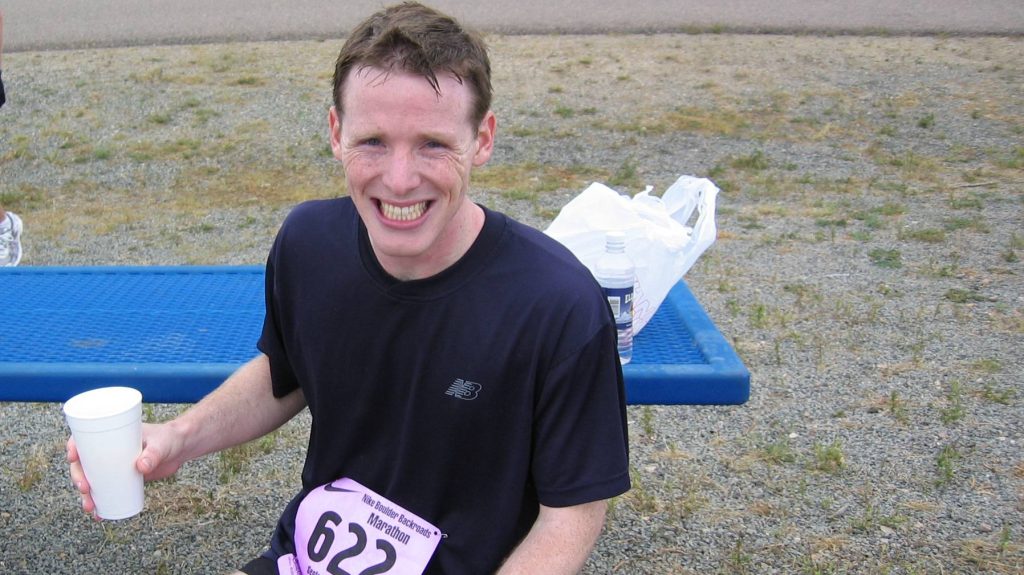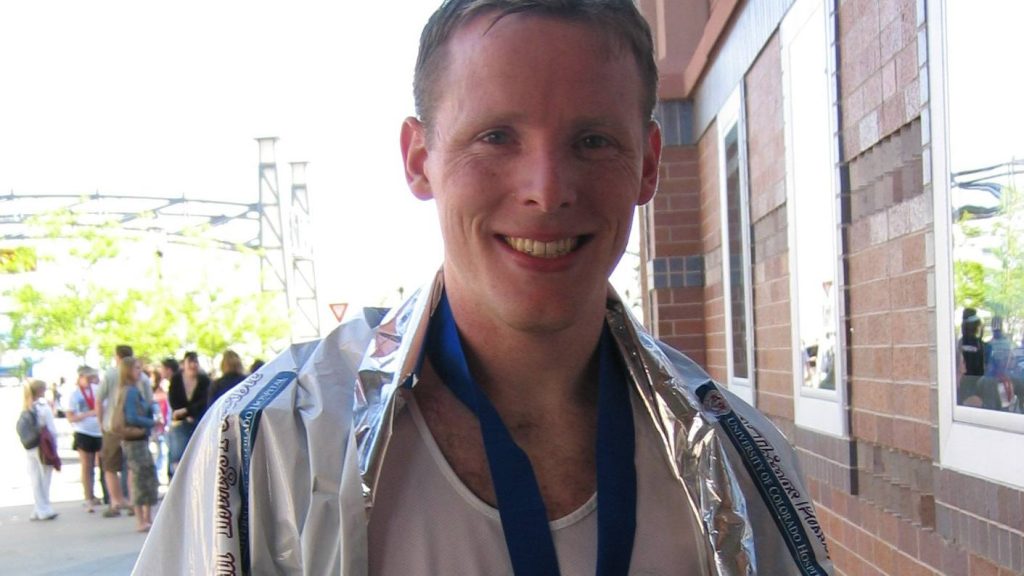
Jeff Helfrich, 41, began running in 5th grade. He competed from grade school through high school in Illinois and was good enough to walk onto the track and cross-country teams at Harvard University, an NCAA Division I school.
Then came the summer of 2002, an injury, and what became a 20-year search for relief.
Running man
The summer before his senior year, Helfrich was in excellent shape. He had already qualified for the 2003 Boston Marathon. While running a downhill half-marathon in Colorado, he felt extreme pain in his right calf. He thought he just pulled a muscle. He rested and eventually returned to training camp for cross-country.
“I was only able to run one cross-country race that fall when the pain returned,” Helfrich says. “So I rehabbed for most of the season.”
That winter, Helfrich ran indoor track and posted his fastest time in the 5K. That spring, he skipped spring track so he could work on his senior thesis and run the Boston Marathon. He trained solo and completed Boston in 2:46, placing 117th overall.
After graduating, Helfrich moved to Denver for work. He ran for fun and trained for the occasional marathon.
His calf pain flared up periodically, forcing him to stop running for a few months. He tried rehab and massage, but just when he thought he was in the clear, the pain came back. Sometimes his left leg hurt, more often it was the right. Over time, the pain-free periods seemed to get shorter, the recovery periods longer.

No definitive answers
In 2008, Helfrich moved to Dallas for a new job. Over the next few years, he saw various specialists around the country. He underwent MRIs and bone scans. He got cortisone shots, received physical therapy and tried stretching routines. He also received platelet-rich plasma therapy.
One physician suspected chronic exertional compartment syndrome, an exercise-induced muscle and nerve condition that causes pain, swelling and sometimes disability in the affected muscles. The doctor encouraged him to undergo pressure tests for the condition.
Pressure tests -- which involved sticking needles into Helfrich’s calves – showed Helfrich had borderline high results, but they were inconsistent with earlier cases of the syndrome.
“He offered surgery but needed to see what was going on once he got in there,” Helfrich says. “He didn’t have a prognosis. I passed on the surgery.“
On his own, Helfrich continued to research chronic exertional compartment syndrome. He learned about popliteal artery entrapment syndrome, or a pain or cramping in the calf that happens during exercise and goes away during rest. This condition can mimic or coexist with chronic exertional compartment syndrome.
Stealing a run
Eventually, Helfrich decided his running career was over. He switched to biking and rowing. Once in a rare while, he "stole" a run, but it was never consistent.
“I resigned myself to the fact that if I couldn’t run like I once did, I would do what I could and let sleeping dogs lie,” he says. “I remain firmly in that camp today.”
Mayo connection
Helfrich kept up with the scientific literature on his condition. He noticed that more people were finding relief with botulinum toxin (aka Botox). In 2021, he contacted Jonathan Finnoff, D.O., chief medical officer of the U.S. Olympic and Paralympic Committee and former medical director of Mayo Clinic Orthopedics and Sports Medicine in Minneapolis.
Dr. Finnoff recommended Jacob Sellon, M.D., a physiatrist and co-director of Mayo Clinic Orthopedics and Sports Medicine in Rochester, Minn. Helfrich came to Mayo and consulted with Dr. Sellon and vascular surgeon Jill Colglazier, M.D.
Sellon says that Helfrich’s case was unusual as his symptoms did not fit well with the typical symptoms of chronic exertional compartment syndrome, which commonly affects the front our outside part of the leg. Helfrich’s symptoms fit better with popliteal artery entrapment syndrome, though his test results suggested he might have both conditions. Helfrich and his physicians discussed surgery, a traditional treatment for these conditions, but ultimately they decided on botulinum toxin injections.
“The mechanism is not entirely clear, but the thinking is that the toxin is relaxing the muscle around the blood vessels that are entrapped, which allows better blood flow,” Dr. Sellon says.
In July 2021, Dr. Sellon gave Helfrich the injection under ultrasound guidance. Ultrasound guidance allowed Dr. Sellon to target the muscles that appeared to be constricting his popliteal arteries, while avoiding injury to nearby nerves and blood vessels. The effects of the toxin lasts about three months.
In recent years, botulinum toxin injections have been show to help both syndromes, though the duration varies and the injections are considered experimental by most insurance companies, Dr. Sellon says.
Helfrich resumed running. In August 2022, he ran in a 200-mile relay race, the Ragnar Northwest Passage, an eight-year tradition with his buddies. Helfrich completed 11 miles over three legs without problems.
“We actually won the race,” he says. “There was no way I could have done that before Botox.”
Unfortunately, Helfrich’s pain has returned. He knew that this was a possibility and that he might need additional injections. He is planning to get a second round this month near his home in Dallas.
“I don't think I'll ever do the surgery as my prime running days are behind me,” Helfrich says. “The pain and rehab of doing two calves and missing out on other activities during the downtime just doesn't seem worth it. So anything the Botox can give me is a gift.”
Related Articles







